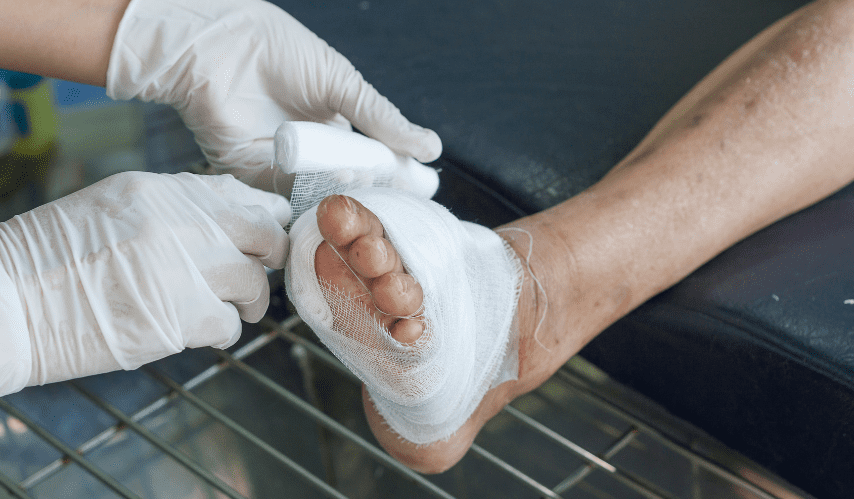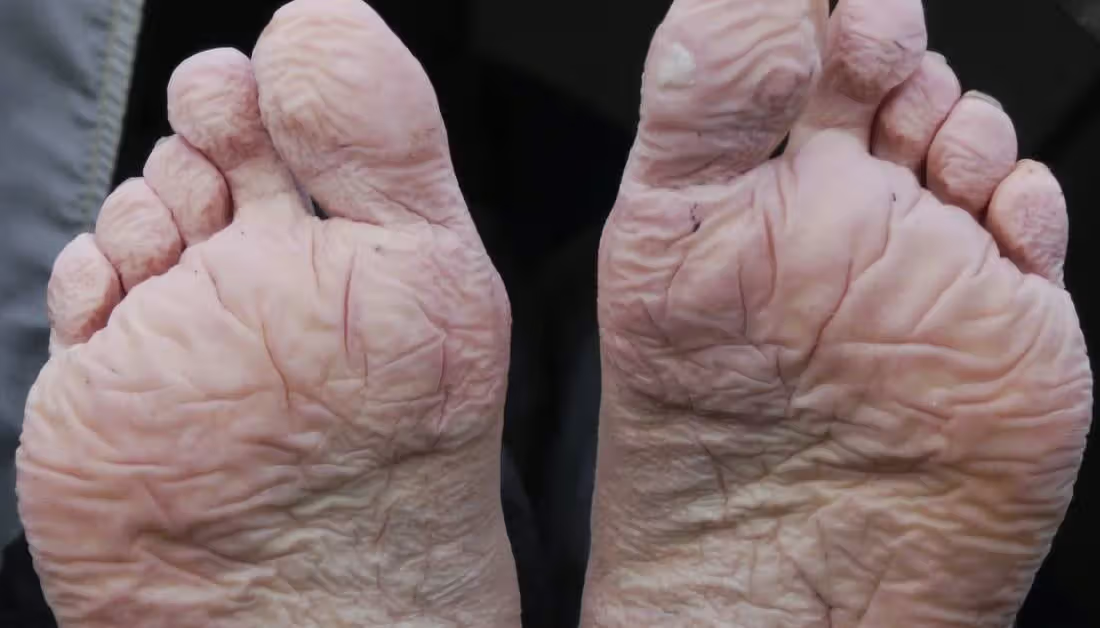What is Trench Foot?

What is trench foot? This question may bring to mind images of soldiers in muddy trenches during World War I. Still, trench foot remains a condition that can affect anyone exposed to cold, wet environments for prolonged periods. Also known as immersion foot, trench foot develops when feet are exposed to moisture, low temperatures, and unsanitary conditions for extended periods. Though modern hygiene and healthcare have reduced its prevalence, trench foot still poses a risk, particularly for outdoor workers, hikers, campers, and military personnel.
In this detailed blog by Chiropodist, we will explore the causes, symptoms, prevention methods, and treatment options for trench foot. We will also discuss how it can be managed with the help of a healthcare professional like a chiropodist. Whether you’re concerned about your foot health or just curious about this historical condition, understanding what trench foot is can help you stay informed and protect your feet in cold, damp conditions.
What Causes Trench Foot?
To understand what trench foot is, it’s essential to know its causes. Trench foot occurs when the feet are exposed to cold, wet, and unsanitary conditions for long periods. The term originated during World War I when soldiers in the trenches were unable to change wet socks and shoes. However, modern cases can arise from camping, hiking, outdoor work, or military training in adverse conditions.
The main factors contributing to trench foot include:
- Prolonged moisture exposure: Keeping feet wet for an extended period without drying them can lead to skin breakdown.
- Cold temperatures: Exposure to temperatures below 15°C (59°F) exacerbates the effects of moisture on the skin and tissues.
- Restricted circulation: Tight boots or shoes can cut off circulation, worsening the damage caused by moisture and cold.
- Unsanitary conditions: Dirt and bacteria in wet environments can increase the risk of infection.
These factors combine to create a situation where the skin begins to break down, leading to pain, swelling, and, if left untreated, more serious complications.
Symptoms of Trench Foot
Recognizing the symptoms of trench foot early is crucial for preventing long-term damage. The symptoms often develop in stages, starting mildly and progressively worsening without intervention. Some of the most common symptoms include:
- Numbness or tingling: The first sign of trench foot is usually a tingling sensation or numbness in the affected foot. This occurs because prolonged cold exposure constricts blood vessels, reducing blood flow to the area.
- Red or blotchy skin: As blood flow decreases, the skin may turn red, blotchy, or pale.
- Swelling: Over time, the foot may swell, making it difficult to walk or move comfortably.
- Blisters and sores: Without proper care, trench foot can cause blisters and open sores to form on the foot.
- Pain: As the condition worsens, the numbness may give way to intense pain, especially as circulation is restored.
- Infection: If left untreated, trench foot can lead to infection, which can be dangerous if the infection spreads.
How Can Trench Foot Be Prevented?
The best way to avoid trench foot is through prevention. Whether you’re working outdoors, hiking, or exposed to wet and cold conditions, taking steps to keep your feet dry and warm is critical. Below are some essential strategies to prevent trench foot.
Keep Feet Dry
Since prolonged exposure to moisture is the primary cause of trench foot, keeping your feet dry is the most effective preventive measure. Regularly changing your socks, especially if they become wet, is a simple but crucial step. Waterproof boots and moisture-wicking socks are essential for staying dry in damp environments.
Wear Proper Footwear
Tight shoes can restrict blood flow to the feet, increasing the risk of developing trench foot. Opt for properly fitted footwear that allows enough room for your feet to move and breathe. Insulated boots can also help maintain warmth and prevent cold-related damage.
Take Foot Wiping Breaks
Taking regular breaks to wipe your feet dry can help prevent moisture buildup. Removing boots, airing your feet, and wiping them with a clean, dry cloth is a great way to avoid moisture accumulation. You can learn more about the benefits of foot wiping as part of a comprehensive foot care routine.
Avoid Prolonged Exposure to Cold and Wet Conditions
If possible, limit your exposure to cold and wet conditions. Taking breaks indoors or keeping your feet elevated during outdoor activities can reduce the strain on your feet. If you’re hiking or working in wet areas, bring extra pairs of socks and shoes to change into when necessary.
Practice Good Foot Hygiene
Regular cleaning and care are vital in preventing infections caused by trench foot. Proper foot hygiene, including washing and drying feet daily, helps maintain skin health. Understanding the importance of foot care is essential for anyone exposed to challenging environments, as it can prevent a range of issues, including trench foot.
Treatment Options for Trench Foot
If you suspect you have trench foot, seeking treatment immediately is crucial. The earlier the condition is treated, the better the chances of a full recovery without long-term damage. Here are some common treatments for trench foot:
Dry and Warm the Feet
The first step in treating trench foot is to remove the affected person from the cold and wet environment and begin drying and warming the feet. It’s essential not to use direct heat, like hot water or heating pads, as this can cause burns. Instead, allow the feet to dry slowly at room temperature.
Elevate the Feet
Elevating the affected feet can help reduce swelling and improve circulation. This simple action can alleviate discomfort and promote healing.
Apply Moisturizers
Moisturizing the skin is important to restore its barrier function. Creams or ointments that lock in moisture without trapping it can be beneficial. Those prone to dryness should also consider strategies to prevent issues like cracked skin by following guides on how to prevent dry feet.
Seek Medical Attention
If the condition worsens or fails to improve, seek medical attention immediately. A chiropodist or podiatrist can assess the damage and recommend appropriate treatment. In severe cases, prescription medications may be necessary to fight infection or alleviate pain.
Professional Foot Care from a Chiropodist
A chiropodist, also known as a foot specialist, plays a crucial role in treating trench foot. They can provide targeted care for trench foot, from cleaning and dressing wounds to prescribing medications. Regular visits to a chiropodist can ensure that your feet remain in good health, even after recovery. Their expertise in foot care helps prevent further complications and can speed up the healing process.
Long-Term Effects of Untreated Trench Foot
Failing to treat trench foot early can result in long-term complications. These can include:
- Chronic pain: Even after recovery, some individuals experience ongoing pain and discomfort in the affected foot.
- Nerve damage: Severe cases of trench foot can lead to permanent nerve damage, affecting sensation in the foot.
- Gangrene: In extreme situations, untreated trench foot can result in tissue death, leading to gangrene. This may require amputation to prevent the infection from spreading.
How Chiropodists Can Help Prevent and Manage Trench Foot
Chiropodists specialize in foot health and are essential in preventing and managing trench foot. By offering routine foot exams and personalized care, they can help those at risk maintain healthy feet, even in challenging environments. Whether you’re looking to prevent trench foot or need help managing symptoms, consulting a chiropodist is a wise step.
Conclusion
What is trench foot? It’s a serious condition that occurs when feet are exposed to cold, wet, and unsanitary conditions for too long. While it’s not as common as it was during wartime, trench foot remains a risk for outdoor workers, military personnel, and adventure enthusiasts. Recognizing the symptoms early, taking preventive steps, and seeking prompt treatment are key to avoiding long-term damage.
If you frequently find yourself in damp or cold environments, maintaining good foot hygiene, keeping your feet dry, and wearing proper footwear is essential. Remember, if you suspect trench foot, early treatment from a healthcare professional like a chiropodist can make all the difference in your recovery.
About Author
Hi, I’m Arezou Hassani, a Chiropodist practicing in Ontario, Canada. I hold a Bachelor of Science in Psychology and an Advanced Diploma in Chiropody. As a member of the College of Chiropodists of Ontario and other professional organizations, I have extensive experience treating foot issues for patients of all ages. I founded Footwyse to bridge innovative research with practical foot care solutions, offering virtual consultations and curated products. I’m passionate about helping people achieve optimal foot health and invite you to join me in this journey toward healthier feet.

